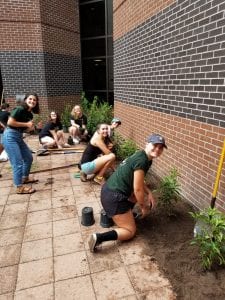Reinvigorating UCF Landscapes with the Bee Campus USA team

Our new Bee Campus USA program co-coordinators transformed a rock-covered corner of a campus courtyard into a beautiful pollinator garden!
The transformed area is in the courtyard of the business administration 1 building where there were several strips and cutout areas covered in black lava rock. Irrigation heads provided evidence that these areas originally had landscape material. Beautifying this area would require reestablishing plants in a challenging environment. Our two new Bee Campus USA co-coordinators, Madison Schmidt and Rachel Gutner, stepped up to the challenge with enthusiasm, and with the help of their interns and Arboretum volunteers they transformed this lifeless area into a thriving pollinator garden in their first landscape design and installation project.
The first step in the project was to determine whether the original irrigation system was still working and to check the soil conditions underneath the rock. In the spirit of supporting our students, the campus landscape installation team checked the irrigation, removed the rock and replaced it with topsoil.
The next challenge was to come up with suitable plant candidates that could survive in the unusual condition of the courtyard—shaded in the morning and evening, but exposed to harsh sunlight in the middle of the day. The students researched different plants and bounced ideas off their mentor, UCF Arboretum Director, Dr. Patrick Bohlen.
The final plant list included hardy native plants that could withstand the combination of partially shaded conditions and intense sun. The chosen plants included native stalwarts such as beautyberry, Callicarpa americana, whose striking purple berries are a hallmark of autumn beauty in Central Florida; Firebush, Hamelia patens, whose year-round blooms provide a continuous food source for pollinators and wild coffee; Psychotria nervosa, a native shrub with glossy, dark-green foliage and tiny white flowers that are a favorite of pollinators when they bloom in late spring. The planting also features the daisy-like Starry rosinweed, Silphium astericus, whose bright yellow flowers turn their faces toward the sun, Rouge plant, Rivinia humilis, a small shrub that produces spikes of delicate pink flowers that turn into bright red berries prized by birds; and Dwarf Powderpuff, Calliandra emarginata, a small tree from South and Central America that produces abundant, acacia-like red flowers for much of the year. The final touch was native lantana, planted around the base of the business school fraternity monument.
The new plants are doing great so far, and the Bee Campus co-coordinators will continue to maintain them with their interns and groups of volunteers. The undergraduate business student fraternity was instrumental in getting this project started, and we thank them for their motivation and support!
